Kajetan Schweighofer
Addressing Pitfalls in the Evaluation of Uncertainty Estimation Methods for Natural Language Generation
Oct 02, 2025Abstract:Hallucinations are a common issue that undermine the reliability of large language models (LLMs). Recent studies have identified a specific subset of hallucinations, known as confabulations, which arise due to predictive uncertainty of LLMs. To detect confabulations, various methods for estimating predictive uncertainty in natural language generation (NLG) have been developed. These methods are typically evaluated by correlating uncertainty estimates with the correctness of generated text, with question-answering (QA) datasets serving as the standard benchmark. However, commonly used approximate correctness functions have substantial disagreement between each other and, consequently, in the ranking of the uncertainty estimation methods. This allows one to inflate the apparent performance of uncertainty estimation methods. We propose using several alternative risk indicators for risk correlation experiments that improve robustness of empirical assessment of UE algorithms for NLG. For QA tasks, we show that marginalizing over multiple LLM-as-a-judge variants leads to reducing the evaluation biases. Furthermore, we explore structured tasks as well as out of distribution and perturbation detection tasks which provide robust and controllable risk indicators. Finally, we propose to use an Elo rating of uncertainty estimation methods to give an objective summarization over extensive evaluation settings.
xLSTM Scaling Laws: Competitive Performance with Linear Time-Complexity
Oct 02, 2025Abstract:Scaling laws play a central role in the success of Large Language Models (LLMs), enabling the prediction of model performance relative to compute budgets prior to training. While Transformers have been the dominant architecture, recent alternatives such as xLSTM offer linear complexity with respect to context length while remaining competitive in the billion-parameter regime. We conduct a comparative investigation on the scaling behavior of Transformers and xLSTM along the following lines, providing insights to guide future model design and deployment. First, we study the scaling behavior for xLSTM in compute-optimal and over-training regimes using both IsoFLOP and parametric fit approaches on a wide range of model sizes (80M-7B) and number of training tokens (2B-2T). Second, we examine the dependence of optimal model sizes on context length, a pivotal aspect that was largely ignored in previous work. Finally, we analyze inference-time scaling characteristics. Our findings reveal that in typical LLM training and inference scenarios, xLSTM scales favorably compared to Transformers. Importantly, xLSTM's advantage widens as training and inference contexts grow.
Uncertainty Quantification for Regression using Proper Scoring Rules
Sep 30, 2025Abstract:Quantifying uncertainty of machine learning model predictions is essential for reliable decision-making, especially in safety-critical applications. Recently, uncertainty quantification (UQ) theory has advanced significantly, building on a firm basis of learning with proper scoring rules. However, these advances were focused on classification, while extending these ideas to regression remains challenging. In this work, we introduce a unified UQ framework for regression based on proper scoring rules, such as CRPS, logarithmic, squared error, and quadratic scores. We derive closed-form expressions for the resulting uncertainty measures under practical parametric assumptions and show how to estimate them using ensembles of models. In particular, the derived uncertainty measures naturally decompose into aleatoric and epistemic components. The framework recovers popular regression UQ measures based on predictive variance and differential entropy. Our broad evaluation on synthetic and real-world regression datasets provides guidance for selecting reliable UQ measures.
ImageSet2Text: Describing Sets of Images through Text
Mar 25, 2025



Abstract:We introduce ImageSet2Text, a novel approach that leverages vision-language foundation models to automatically create natural language descriptions of image sets. Inspired by concept bottleneck models (CBMs) and based on visual-question answering (VQA) chains, ImageSet2Text iteratively extracts key concepts from image subsets, encodes them into a structured graph, and refines insights using an external knowledge graph and CLIP-based validation. This iterative process enhances interpretability and enables accurate and detailed set-level summarization. Through extensive experiments, we evaluate ImageSet2Text's descriptions on accuracy, completeness, readability and overall quality, benchmarking it against existing vision-language models and introducing new datasets for large-scale group image captioning.
Rethinking Uncertainty Estimation in Natural Language Generation
Dec 19, 2024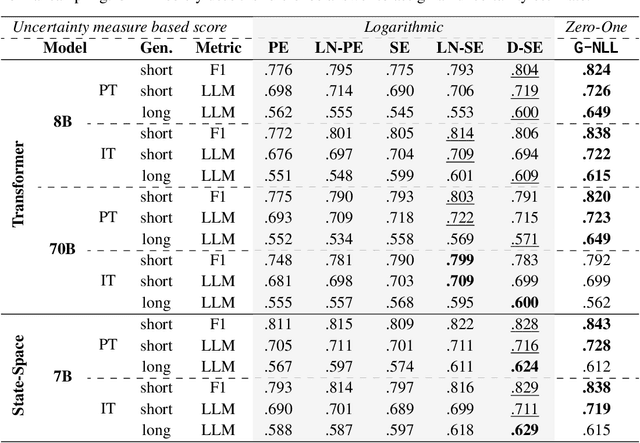
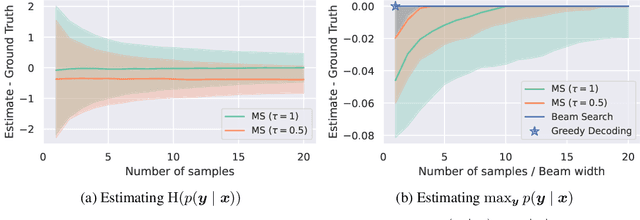
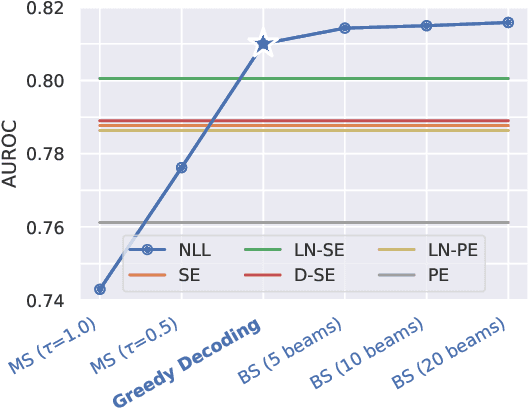
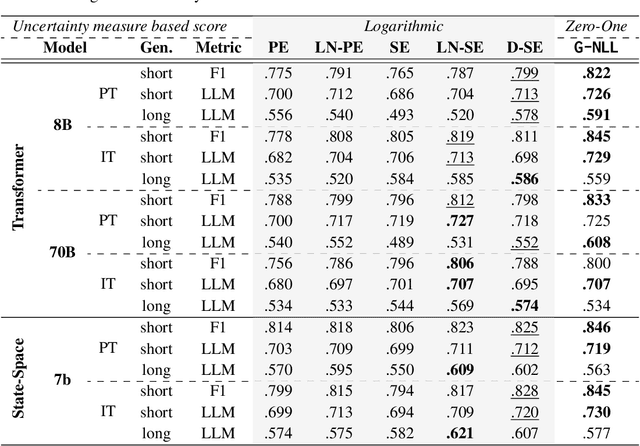
Abstract:Large Language Models (LLMs) are increasingly employed in real-world applications, driving the need to evaluate the trustworthiness of their generated text. To this end, reliable uncertainty estimation is essential. Since current LLMs generate text autoregressively through a stochastic process, the same prompt can lead to varying outputs. Consequently, leading uncertainty estimation methods generate and analyze multiple output sequences to determine the LLM's uncertainty. However, generating output sequences is computationally expensive, making these methods impractical at scale. In this work, we inspect the theoretical foundations of the leading methods and explore new directions to enhance their computational efficiency. Building on the framework of proper scoring rules, we find that the negative log-likelihood of the most likely output sequence constitutes a theoretically grounded uncertainty measure. To approximate this alternative measure, we propose G-NLL, which has the advantage of being obtained using only a single output sequence generated by greedy decoding. This makes uncertainty estimation more efficient and straightforward, while preserving theoretical rigor. Empirical results demonstrate that G-NLL achieves state-of-the-art performance across various LLMs and tasks. Our work lays the foundation for efficient and reliable uncertainty estimation in natural language generation, challenging the necessity of more computationally involved methods currently leading the field.
The Disparate Benefits of Deep Ensembles
Oct 17, 2024



Abstract:Ensembles of Deep Neural Networks, Deep Ensembles, are widely used as a simple way to boost predictive performance. However, their impact on algorithmic fairness is not well understood yet. Algorithmic fairness investigates how a model's performance varies across different groups, typically defined by protected attributes such as age, gender, or race. In this work, we investigate the interplay between the performance gains from Deep Ensembles and fairness. Our analysis reveals that they unevenly favor different groups in what we refer to as a disparate benefits effect. We empirically investigate this effect with Deep Ensembles applied to popular facial analysis and medical imaging datasets, where protected group attributes are given and find that it occurs for multiple established group fairness metrics, including statistical parity and equal opportunity. Furthermore, we identify the per-group difference in predictive diversity of ensemble members as the potential cause of the disparate benefits effect. Finally, we evaluate different approaches to reduce unfairness due to the disparate benefits effect. Our findings show that post-processing is an effective method to mitigate this unfairness while preserving the improved performance of Deep Ensembles.
On Information-Theoretic Measures of Predictive Uncertainty
Oct 14, 2024Abstract:Reliable estimation of predictive uncertainty is crucial for machine learning applications, particularly in high-stakes scenarios where hedging against risks is essential. Despite its significance, a consensus on the correct measurement of predictive uncertainty remains elusive. In this work, we return to first principles to develop a fundamental framework of information-theoretic predictive uncertainty measures. Our proposed framework categorizes predictive uncertainty measures according to two factors: (I) The predicting model (II) The approximation of the true predictive distribution. Examining all possible combinations of these two factors, we derive a set of predictive uncertainty measures that includes both known and newly introduced ones. We empirically evaluate these measures in typical uncertainty estimation settings, such as misclassification detection, selective prediction, and out-of-distribution detection. The results show that no single measure is universal, but the effectiveness depends on the specific setting. Thus, our work provides clarity about the suitability of predictive uncertainty measures by clarifying their implicit assumptions and relationships.
Semantically Diverse Language Generation for Uncertainty Estimation in Language Models
Jun 06, 2024
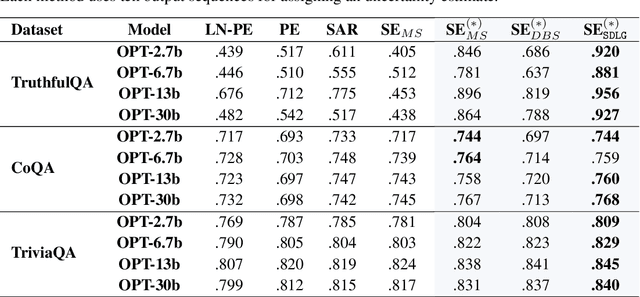

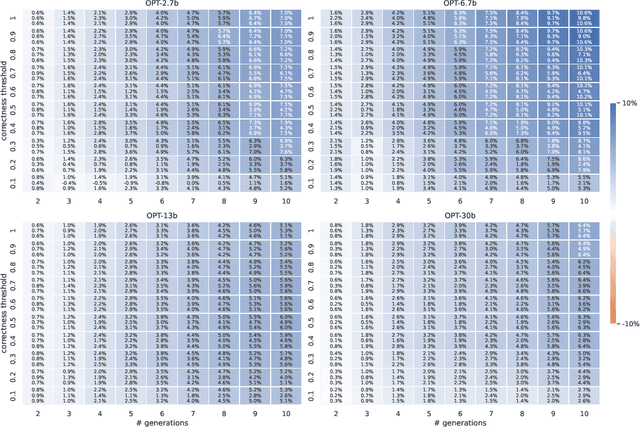
Abstract:Large language models (LLMs) can suffer from hallucinations when generating text. These hallucinations impede various applications in society and industry by making LLMs untrustworthy. Current LLMs generate text in an autoregressive fashion by predicting and appending text tokens. When an LLM is uncertain about the semantic meaning of the next tokens to generate, it is likely to start hallucinating. Thus, it has been suggested that hallucinations stem from predictive uncertainty. We introduce Semantically Diverse Language Generation (SDLG) to quantify predictive uncertainty in LLMs. SDLG steers the LLM to generate semantically diverse yet likely alternatives for an initially generated text. This approach provides a precise measure of aleatoric semantic uncertainty, detecting whether the initial text is likely to be hallucinated. Experiments on question-answering tasks demonstrate that SDLG consistently outperforms existing methods while being the most computationally efficient, setting a new standard for uncertainty estimation in LLMs.
Introducing an Improved Information-Theoretic Measure of Predictive Uncertainty
Nov 14, 2023Abstract:Applying a machine learning model for decision-making in the real world requires to distinguish what the model knows from what it does not. A critical factor in assessing the knowledge of a model is to quantify its predictive uncertainty. Predictive uncertainty is commonly measured by the entropy of the Bayesian model average (BMA) predictive distribution. Yet, the properness of this current measure of predictive uncertainty was recently questioned. We provide new insights regarding those limitations. Our analyses show that the current measure erroneously assumes that the BMA predictive distribution is equivalent to the predictive distribution of the true model that generated the dataset. Consequently, we introduce a theoretically grounded measure to overcome these limitations. We experimentally verify the benefits of our introduced measure of predictive uncertainty. We find that our introduced measure behaves more reasonably in controlled synthetic tasks. Moreover, our evaluations on ImageNet demonstrate that our introduced measure is advantageous in real-world applications utilizing predictive uncertainty.
Quantification of Uncertainty with Adversarial Models
Jul 06, 2023



Abstract:Quantifying uncertainty is important for actionable predictions in real-world applications. A crucial part of predictive uncertainty quantification is the estimation of epistemic uncertainty, which is defined as an integral of the product between a divergence function and the posterior. Current methods such as Deep Ensembles or MC dropout underperform at estimating the epistemic uncertainty, since they primarily consider the posterior when sampling models. We suggest Quantification of Uncertainty with Adversarial Models (QUAM) to better estimate the epistemic uncertainty. QUAM identifies regions where the whole product under the integral is large, not just the posterior. Consequently, QUAM has lower approximation error of the epistemic uncertainty compared to previous methods. Models for which the product is large correspond to adversarial models (not adversarial examples!). Adversarial models have both a high posterior as well as a high divergence between their predictions and that of a reference model. Our experiments show that QUAM excels in capturing epistemic uncertainty for deep learning models and outperforms previous methods on challenging tasks in the vision domain.
 Add to Chrome
Add to Chrome Add to Firefox
Add to Firefox Add to Edge
Add to Edge